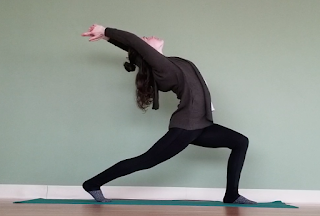A lunge is such an awesome pose. Seriously it is versatile as can be. From a passive lunge to help stech out, to an overhead lunge building core, leg, and upper body strength. Lunges are absolutely amazing. This blog will cover 1 specific lunge: a static engaged lunge, or crescent lunge. This is a strength building lunge that is held rather than in motion.
This pose is referred to as anjaneyasana in yoga. The term anjayeya is a matronymic reference to the lord Hanuman using his mothers name, Anjani. Lord Hanuman is a central part of Hindu devotional worship, Believed to be an incarnation of lord Shiva, and is often portrayed as resembling a monkey. The pose resembles a young divine child reaching towards the sky and the warmth of the sun, captivated by a glowing fruit in the sky as depicted in the traditional epic.
How to:
From standing (Moutain):
Shift weight to right foot lifting left foot up out in front of you with the knee bent. Find your balance.
Then step back with the left foot landing softly on the balls of the feet with your toes facing front, knee down, and hips square. Take a moment to adjust.
From Downward Dog:
Lift your right foot up as high as you can while keeping your hips square.
Tuck the right knee in towards your nose. Then step the foot up between your hands.
Come up on to the fingertips as you adjust your feet to find your balance, then lift the torso upright. Taking the hands to the hips to square them off.
Take a deep breath in and as you exhale, let yourself sink down in this lunge as deep as you can comfortably. For the most traditional posture, raise your hands above your head reaching your fingertips up towards the sky while keeping your shoulders relaxed.
Modifications:
Anything with your arms reaching overhead is great way to engage the core, even in this lunge where you aren’t holding any additional weights. However In cases of shoulder injuries and some back injuries, keeping your arms over head is not the best idea. Here are some alternatives:
Hands on the hips: If you are someone who is trying to work on alignments, this is a great way to get physical feedback as to where your body is in space and what its doing.
Backwards prayer hands: If you want to get the benefits of a heart opener but don’t have backbend in your lunge, then is is a great way to get this.
Doing the same pose over and over again can get boring, and so is simply holding a pose for a long time. Twists are a great addition to a lunge to add some varritions to your lunge.
I also demonstrated here a modification for those who cannot reach the floor. Simply allow your elbow to rest on your knee.
A closed twist with hands at heart center
Upright: When we bend forwards to hook the elbow, we are often distracted from the natural twist to a more over exaggerated twist which relies heavily on how much you can twist yourself around using your arms. Also more easily accessed for those struggling with balancing in a lunge twist.
A Bind: To bind your twist you must first be able to do a low twisting lunge. From here lets say your doing a lunge on your right leg and you are twisting to the right. You will take your right arm up and over your body so that your right hand is behind your back right around the lumbar portion of your spine. Your left arm will scoop under your body so that your right leg is being held in your left armpit. With your left hand, reach for your right wrist. If you can reach it, clasp it. This is your bind. If you cannot reach you can use a strap to help extend your reach.

Backbend: Back bends are an option when in a lunge. They require a lot of balance so only do it when you feel sturdy and balanced. When you take a backbend, make sure that you keep a bend in the back knee to help make sure you don’t over stretch the hamstring.
Sidebend: Side bends are also an option for a lunge variation. These bends also require a lot of balancing so again it’s important for you to keep a bend in the back knee.
Runners Lunge: This is a hybrid of a low lunge, and a high lunge. For this lunge, you will keep the back knee up off the ground and the back leg engaged. Lean your body forward with your fingertips on the ground. Keeping your fingertips on the ground will help you with finding and keeping your balance.
Benefits:
Physical
-stretches the legs, groin, and hip flexors, while also opening the front torso, chest, and shoulders
-strengthens and tones the thighs, hips, and butt, while strengthening and stretching the thighs, calves and ankles
-considered a balance pose, backbend, and heart opener
-helps the front of the body to expand, which increases energy and reduces fatigue.
-creates flexible strength
-promotes stability in the front and back of the torso
-tones the lower body
-stretches the chest, lungs, shoulders, arms, neck, belly, groins (psoas) and the muscles of the back
Energetic
-develops stamina and endurance in your thighs
-improves your balance, concentration and core awareness
-calms the mind
Cautions:
Do not practice Crescent Lunge if you are currently experiencing high blood pressure or heart problems. Also, avoid this pose if you have a knee or spinal injury. Always work within your own range of limits and abilities. If you have any medical concerns, talk with your doctor before practicing yoga.
Those with shoulder problems should not raise their arms above their head, instead placing their hands on their front thigh
Those with neck or spinal injuries should not take the backbend










